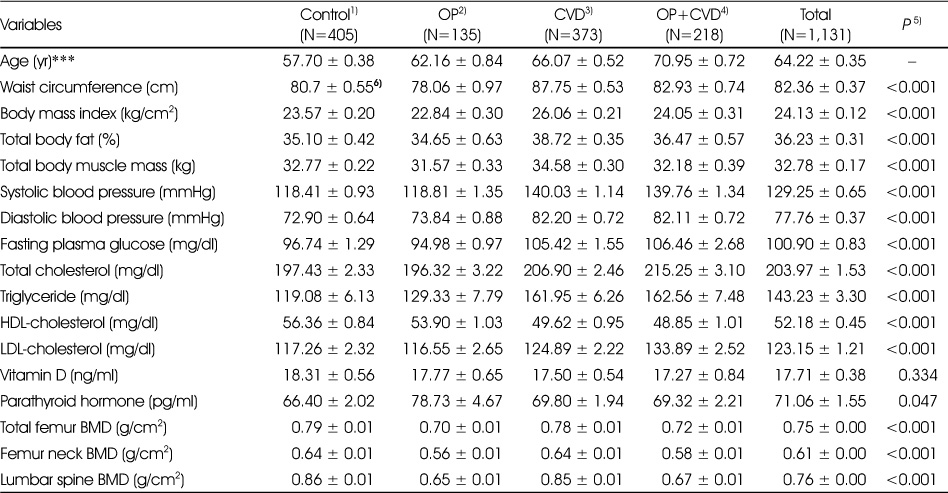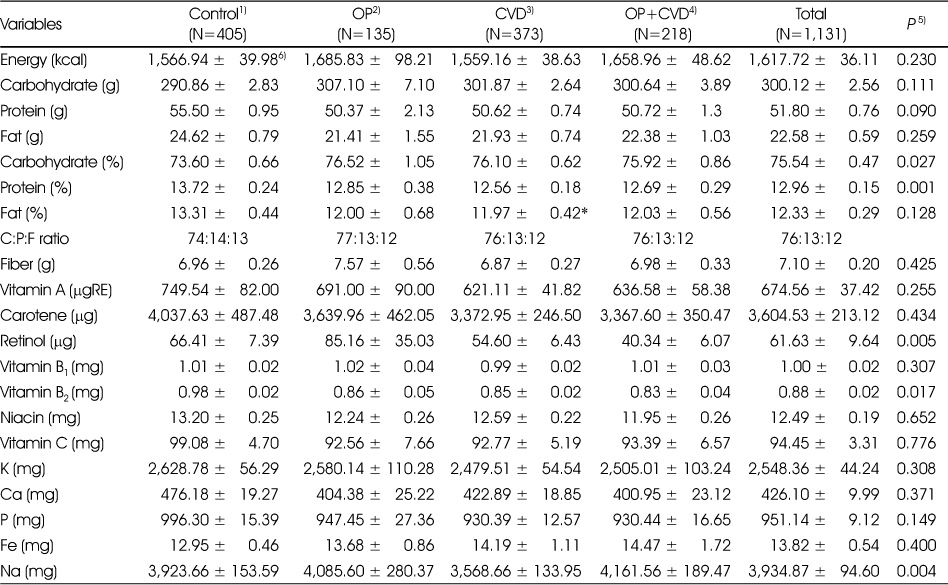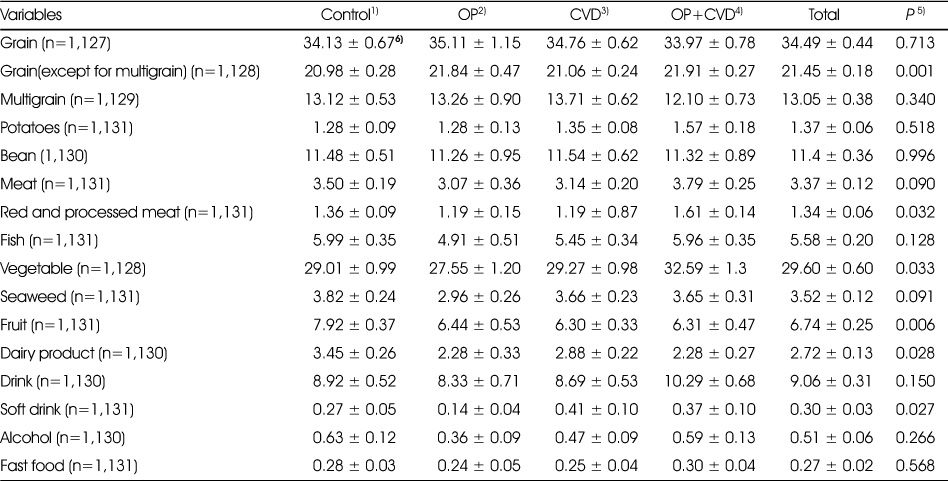Articles
- Page Path
- HOME > Korean J Community Nutr > Volume 24(2); 2019 > Article
-
Research Article
- Food and Nutrient Intake Level by the Risk of Osteoporosis and Cardiovascular Disease in Postmenopausal Women: The use of the 5th Korean National Health and Nutrition Examination Surveys (2010–2011)
-
Hyobin Kim
 , Heysook Kim
, Heysook Kim , Oran Kwon
, Oran Kwon , Heejung Park
, Heejung Park
-
Korean Journal of Community Nutrition 2019;24(2):152-162.
DOI: https://doi.org/10.5720/kjcn.2019.24.2.152
Published online: April 30, 2019
1The Graduate School of Converging Clinical & Public Health, Ewha Womans University, Seoul 03760, Korea, Student.
2Department of Nutritional Science and Food Management, Ewha Womans University, Seoul 03760, Korea, Professor.
3Department of Foods & Nutrition, Yuhan University, Seoul 14780, Korea, Professor.
- Corresponding author: Park, Heejung. Department of Foods & Nutrition, Yuhan University, 590, Gyeongin-ro, Bucheon-si, Gyeonggi-do 14780, Korea. Tel: (02) 2610-0809, Fax: (02) 2610-0806, hjpark@yuhan.ac.kr
Copyright © 2019 The Korean Society of Community Nutrition
This is an Open-Access article distributed under the terms of the Creative Commons Attribution Non-Commercial License (http://creativecommons.org/licenses/by-nc/3.0/) which permits unrestricted non-commercial use, distribution, and reproduction in any medium, provided the original work is properly cited.
- 962 Views
- 2 Download
- 5 Crossref
Abstract
-
Objectives
- The purpose of this study was to investigate the food, nutrient intake, and diet quality of postmenopausal women at high risk of osteoporosis (OP) and cardiovascular disease (CVD) compared with those of control subjects.
-
Methods
- A total of 1,131 post-menopausal women aged over 45 years, who took the 2010–2011 Korean National Health and Nutrition Examination Survey (KNHANES), were included for analysis. These participants were classified into the following groups: the OP group, with a risk of OP (n=135); the CVD group, with a risk of CVD (n=373); the OP+CVD group, with a risk of OP and CVD concurrently (n=218); and the control group (n=405) according to bone mineral density (BMD) and CVD risk. Anthropometric measurements, blood profiles, dietary intake, and dietary quality indices were measured and compared among the four groups.
-
Results
- Waist circumference, total body fat percentage, blood pressure, fasting plasma glucose, total cholesterol, triglyceride, and LDL-cholesterol were higher, and HDL-cholesterol and BMD were lower in the OP+CVD group than in the control group. In the food frequency questionnaire, the OP+CVD group had significantly higher frequencies of grain (except for multi-grain) and lower frequencies of fruit and dairy product. The frequency of consumption of red meat, processed meat, and carbonated beverages was higher in OP+CVD group. In nutrient density analysis, proteins and vitamin B2 levels were significantly lower in the OP+CVD group than in the control group. The nutritional quality index (INQ) values of calcium were in the order of 0.63, 0.58, 0.56, and 0.55 in each group, and it was urgent to improve the dietary intake for calcium in postmenopausal women. In addition, vitamin B2 was inadequately consumed by all groups.
-
Conclusions
- These results suggest that it is necessary to increase the intake of vitamin B2 and calcium and decrease the frequency of intake of red meat, processed meat, and carbonated beverages in postmenopausal women with the risk of OP and CVD.
- 1. Santoro N, Epperson CN, Mathews SB. Menopausal symptoms and their management. Endocrinol Metab Clin North Am 2015; 44(3): 497-515.ArticlePubMedPMC
- 2. Choi SH, Hwang DK, Song HR, Noh HJ, Kang JY, Choi DH. The predictors for lumbar spinal bone mineral density in premenopausal and postmenopausal women in Korea. J Korean Soc Menopause 2009; 15(2): 101-109.
- 3. Kim DS, Shon HC, Kim YM, Choi ES, Park KJ, Im SH. Postoperative mortality and the associated factors for senile hip fracture patients. J Korean Orthop Assoc 2008; 43(4): 488-494.Article
- 4. Sang JH, Hwang IC, Han HS, Lee WS, Kim TE, Lee HH. Prevalence of osteoporosis and osteopenia in women in Gumi Gyeongbuk province. J Korean Soc Menopause 2012; 18(1): 28-35.Article
- 5. Laroche M, Pécourneau V, Blain H, Breuil V, Chapurlat R, Cortet B. Osteoporosis and ischemic cardiovascular disease. Joint Bone Spine 2017; 84(4): 427-432.ArticlePubMed
- 6. So HY, Ahn SH, Song RY, Kim HL. Relationships among obesity, bone mineral density, and cardiovascular risks in post-menopausal women. Korean J Women Health Nurs 2010; 16(3): 224-233.ArticlePubMed
- 7. Cho JH. Assessment of women's health during menopausal periods. KCDC; 2013 05. Report No.1465012632.
- 8. Avramovski P, Avramovska M, Sikole A. Bone strength and arterial stiffness impact on cardiovascular mortality in a general population. J Osteoporos 2016; 2016: 7030272.ArticlePubMedPMCPDF
- 9. Lian XL, Zhang YP, Li X, Jing LD, Cairang ZM, Gou JQ. Exploration on the relationship between the elderly osteoporosis and cardiovascular disease risk factors. Eur Rev Med Pharmacol Sci 2017; 21(19): 4386-4390.PubMed
- 10. Den Uyl D, Nurmohamed MT, van Tuyl LH, Raterman HG, Lems WF. (Sub)clinical cardiovascular disease is associated with increased bone loss and fracture risk; a systematic review of the association between cardiovascular disease and osteoporosis. Arthritis Res Ther 2011; 13(1): R5.ArticlePubMedPMC
- 11. von der Recke P, Hansen MA, Hassager C. The association between low bone mass at the menopause and cardiovascular mortality. Am J Med 1999; 106(3): 273-278.ArticlePubMed
- 12. Farhat GN, Newman AB, Sutton-Tyrrell K, Matthews KA, Boudreau R, Schwartz AV. The association of bone mineral density measures with incident cardiovascular disease in older adults. Osteoporos Int 2007; 18(7): 999-1008.ArticlePubMedPDF
- 13. Collins TC, Ewing SK, Diem SJ, Taylor BC, Orwoll ES, Cummings SR. Peripheral arterial disease is associated with higher rates of hip bone loss and increased fracture risk in older men. Circulation 2009; 119(17): 2305-2312.ArticlePubMedPMC
- 14. Naves M, Rodriguez-Garcia M, Diaz-Lopez JB, Gomez-Alonso C, Cannata-Andia JB. Progression of vascular calcifications is associated with greater bone loss and increased bone fractures. Osteoporos Int 2008; 19(8): 1161-1166.ArticlePubMedPDF
- 15. Bagger YZ, Tanko LB, Alexandersen P, Qin G, Christiansen C. Radiographic measure of aorta calcification is a site-specific predictor of bone loss and fracture risk at the hip. J Intern Med 2006; 259(6): 598-605.ArticlePubMed
- 16. Hak AE, Pols HA, van Hemert AM, Hofman A, Witteman JC. Progression of aortic calcification is associated with metacarpal bone loss during menopause: a population-based longitudinal study. Arterioscler Thromb Vasc Biol 2000; 20(8): 1926-1931.PubMed
- 17. Doherty TM, Fitzpatrick LA, Inoue D, Qiao JH, Fishbein MC, Detrano RC. Molecular, endocrine, and genetic mechanisms of arterial calcification. Endocr Rev 2004; 25(4): 629-672.ArticlePubMed
- 18. Bhupathiraju SN, Lichtenstein AH, Dawson-Hughes B, Hannan MT, Tucker KL. Adherence to the 2006 American Heart Association Diet and Lifestyle Recommendations for cardiovascular disease risk reduction is associated with bone health in older Puerto Ricans. Am J Clin Nutr 2013; 98(5): 1309-1316.ArticlePubMedPMC
- 19. Beulens JW, Bots ML, Atsma F, Bartelink ML, Prokop M, Geleijnse JM. High dietary menaquinone intake is associated with reduced coronary calcification. Atherosclerosis 2009; 203(2): 489-493.ArticlePubMed
- 20. Choi SN, Jho KH, Chung NY. Evaluation of anthropometric characteristics, bone density, food intake frequency, nutrient intakes, and diet quality of pre- and postmenopausal women: based on 2008~2011 Korean National Health and Nutrition Examination Survey. J East Asian Soc Diet Life 2017; 27(5): 500-511.Article
- 21. Kim MH. Comparison of chronic disease risk by abdominal obesity in Korean adult women. Korean J Food Nutr 2016; 29(6): 938-945.
- 22. D'Agostino RB, Vasan RS, Pencina MJ, Wolf PA, Cobain M, Massaro JM. General cardiovascular risk profile for use in primary care: the Framingham Heart Study. Circulation 2008; 117(6): 743-753.ArticlePubMed
- 23. Oguoma VM, Nwose EU, Skinner TC, Richards RS, Digban KA, Onyia IC. Association between metabolic syndrome and 10-year risk of developing cardiovascular disease in a Nigerian population. Int Health 2016; 8(5): 354-359.ArticlePubMed
- 24. Eastell R, Newman C, Crossman DC. Cardiovascular disease and bone. Arch Biochem Biophys 2010; 503(1): 78-83.ArticlePubMed
- 25. Shen C, Deng J, Zhou R, Chen J, Fan S, Li Z. Relation between bone mineral density, bone loss and the risk of cardiovascular disease in a Chinese cohort. Am J Cardiol 2012; 110(8): 1138-1142.ArticlePubMed
- 26. Lello S, Capozzi A, Scambia G. Osteoporosis and cardiovascular disease: an update. Gynecol Endocrinol 2015; 31(8): 590-594.ArticlePubMed
- 27. Kim CJ, Oh KW, Rhee EJ, Kim KH, Jo SK, Jung CH. Relationship between body composition and bone mineral density (BMD) in perimenopausal Korean women. Clin Endocrinol (Oxf) 2009; 71(1): 18-26.ArticlePubMed
- 28. Lee JY, Jeong KA, Cha YJ, Kim HY. The relationship between body composition, serum lipid profile and bone mineral density in Korean women. Osteoporos Sarcopenia 2009; 7(3): 159-167.
- 29. Schulze MB, Hoffmann K, Manson JE, Willett WC, Meigs JB, Weikert C. Dietary pattern, inflammation, and incidence of type 2 diabetes in women. Am J Clin Nutr 2005; 82(3): 675-684.ArticlePubMed
- 30. Sadakane A, Tsutsumi A, Gotoh T, Ishikawa S, Ojima T, Kario K. Dietary patterns and levels of blood pressure and serum lipids in a Japanese population. J Epidemiol 2008; 18(2): 58-67.ArticlePubMedPMC
- 31. Romaguera D, Ängquist L, Du H, Jakobsen MU, Forouhi NG, Halkjær J. Food composition of the diet in relation to changes in waist circumference adjusted for body mass index. PLoS One 2011; 6(8): e23384.ArticlePubMedPMC
- 32. Smidowicz A, Regula J. Effect of nutritional status and dietary patterns on human serum C-reactive protein and interleukin-6 concentrations. Adv Nutr 2015; 6(6): 738-747.ArticlePubMedPMC
- 33. Koh JM, Khang YH, Jung CH, Bae S, Kim DJ, Chung YE. Higher circulating hsCRP levels are associated with lower bone mineral density in healthy pre- and postmenopausal women: evidence for a link between systemic inflammation and osteoporosis. Osteoporos Int 2005; 16(10): 1263-1271.ArticlePubMedPDF
- 34. Kim EK, Lee JS, Hong HO, Yu CH. Association between glycemic index, glycemic load, dietary carbohydrates and diabetes from Korean National Health and Nutrition Examination Survey 2005. Korean J Nutr 2009; 42(7): 622-630.Article
- 35. Bae YJ, Sung CJ. A comparison between postmenopausal osteoporotic women and normal women of their nutrient intakes and the evaluation of diet quality. Korean J Community Nutr 2005; 10(2): 205-215.
- 36. Kong SH, Kim JH, Hong AR, Cho NH, Shin CS. Dietary calcium intake and risk of cardiovascular disease, stroke, and fracture in a population with low calcium intake. Am J Clin Nutr 2017; 106(1): 27-34.ArticlePubMed
REFERENCES
Anthropometric characteristics of the subjects

1) Control: Normal group
2) OP: Osteoporosis group
3) CVD: High risk group for cardiovascular disease
4) OP+CVD: High risk group for OP and CVD
5) P-values was obtained from general linear model (GLM) for continuous variables after adjusting for age
6) Age-adjusted Mean ± SD
***: Significantly different among the groups at p<0.001
Figure & Data
REFERENCES
Citations

- Arterial stiffness index, physical activity and food and nutrient intake: cross-sectional study in adults aged 40 years and older
Eun-A Kim, Yun-Mi Kim, Eun-Kyung Kim
Korean Journal of Community Nutrition.2024; 29(2): 81. CrossRef - Comparison of the Nutrient Intake and Health Status of Elderly Koreans According to their BMI Status: Focus on the Underweight Elderly Population
You-Sin Lee, Yoonna Lee
Korean Journal of Community Nutrition.2022; 27(5): 422. CrossRef - Association between frailty and dietary intake amongst the Korean elderly: based on the 2018 Korean National Health and Nutrition Examination Survey
Suhyeon Yang, Won Jang, Yangha Kim
Journal of Nutrition and Health.2021; 54(6): 631. CrossRef - Cardiorespiratory Fitness is Inversely Associated with Risk of Low Bone Mineral Density in Older Korean Men
Inhwan Lee, Jeonghyeon Kim, Hyunsik Kang
International Journal of Environmental Research and Public Health.2020; 17(21): 7907. CrossRef - Research Trend of Nutrition through Analysis of Articles Published in 'Korean Journal of Community Nutrition'
Jin Suk Jo, Kyoung Sin Lee, Ki Nam Kim
Korean Journal of Community Nutrition.2011; 16(2): 278. CrossRef
- We recommend
- Related articles
-
- The dietary factors associated with sleep duration in postmenopausal middle-aged women: a cross-sectional study using 2019–2023 Korea National Health and Nutrition Examination Survey data
- Comparative study on the health and dietary habits of Korean male and female adults before and after the coronavirus disease 2019 pandemic: utilizing data from the 8th Korea National Health and Nutrition Examination Survey (2019–2021)
Group classification by OP and CVD risk criteria
1) Control: Normal group
2) OP: Osteoporosis group
3) CVD: High risk group for cardiovascular disease
4) OP+CVD: High risk group for OP and CVD
Anthropometric characteristics of the subjects
1) Control: Normal group
2) OP: Osteoporosis group
3) CVD: High risk group for cardiovascular disease
4) OP+CVD: High risk group for OP and CVD
5) P-values was obtained from general linear model (GLM) for continuous variables after adjusting for age
6) Age-adjusted Mean ± SD
***: Significantly different among the groups at p<0.001
Daily nutrient intakes of the subjects
1) Control: Normal group
2) OP: Osteoporosis group
3) CVD: High risk group for cardiovascular disease
4) OP+CVD: High risk group for OP and CVD
5) P-values was obtained from general linear model (GLM) for continuous variables after adjusting for age
6) Age-adjusted Mean ± SD
Consumption frequencies of foods of the subjects
1) Control: Normal group
2) OP: Osteoporosis group
3) CVD: High risk group for cardiovascular disease
4) OP+CVD: High risk group for OP and CVD
5) P-values was obtained from general linear model (GLM) for continuous variables after adjusting for age
6) Age-adjusted Mean ± SD
Nutrient Adequacy Ratio (NAR) and Mean Adequacy Ratio (MAR) of the subjects
1) Control: Normal group
2) OP: Osteoporosis group
3) CVD: High risk group for cardiovascular disease
4) OP+CVD: High risk group for OP and CVD
5) P-values was obtained from general linear model (GLM) for continuous variables after adjusting for age
6) Age-adjusted Mean ± SD
Nutrient Density (ND) of the subjects
1) Control: Normal group
2) OP: Osteoporosis group
3) CVD: High risk group for cardiovascular disease
4) OP+CVD: High risk group for OP and CVD
5) P-values was obtained from general linear model (GLM) for continuous variables after adjusting for age
6) Age-adjusted Mean ± SD
Index of Nutritional Quality(INQ) of the subjects
1) Control: Normal group
2) OP: Osteoporosis group
3) CVD: High risk group for cardiovascular disease
4) OP+CVD: High risk group for OP and CVD
5) P-values was obtained from general linear model (GLM) for continuous variables after adjusting for age
6) Age-adjusted Mean ± SD
1) Control: Normal group 2) OP: Osteoporosis group 3) CVD: High risk group for cardiovascular disease 4) OP+CVD: High risk group for OP and CVD
1) Control: Normal group 2) OP: Osteoporosis group 3) CVD: High risk group for cardiovascular disease 4) OP+CVD: High risk group for OP and CVD 5) 6) Age-adjusted Mean ± SD ***: Significantly different among the groups at p<0.001
1) Control: Normal group 2) OP: Osteoporosis group 3) CVD: High risk group for cardiovascular disease 4) OP+CVD: High risk group for OP and CVD 5) 6) Age-adjusted Mean ± SD
1) Control: Normal group 2) OP: Osteoporosis group 3) CVD: High risk group for cardiovascular disease 4) OP+CVD: High risk group for OP and CVD 5) 6) Age-adjusted Mean ± SD
1) Control: Normal group 2) OP: Osteoporosis group 3) CVD: High risk group for cardiovascular disease 4) OP+CVD: High risk group for OP and CVD 5) 6) Age-adjusted Mean ± SD
1) Control: Normal group 2) OP: Osteoporosis group 3) CVD: High risk group for cardiovascular disease 4) OP+CVD: High risk group for OP and CVD 5) 6) Age-adjusted Mean ± SD
1) Control: Normal group 2) OP: Osteoporosis group 3) CVD: High risk group for cardiovascular disease 4) OP+CVD: High risk group for OP and CVD 5) 6) Age-adjusted Mean ± SD

 KSCN
KSCN






 Cite
Cite


